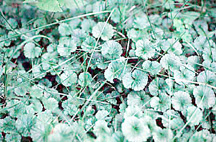Chesapeake Bay's Independent Newspaper ~ Since 1993
1629 Forest Drive, Annapolis, MD 21403 ~ 410-626-9888
Volume XVII, Issue 47 ~ November 19 - November 25, 2009
Home \\ Correspondence \\ from the Editor \\ Submit a Letter \\ Classifieds \\ Contact Us
Dining Guide \\ Home & Garden Guide \\ Archives \\ Distribution Locations \\ Advertising
![]()


|
The Bay Gardener
 by Dr. Frank Gouin |
Don’t Let This Weed Nag Your Lawn
If you’re going to fight it, you need to start now
At the Farmers’ Market in Deale, a customer presented me with plant samples in a plastic bag and asked me how he could kill the bitch weed. Since I had never heard of a plant by that name, I had to open the bag to identify the sample. The weed that he presented me is more appropriately called ground ivy or creeping Charlie, Glechoma hederacea. It is understandable that he called it bitch weed because this weed is very difficult to control in both lawns and gardens.

![]() Ground ivy has a very prostate habit of growth, clinging close to the ground as it grows at a very rapid rate. Its leaves are one- to one-and-a-half inches in diameter, round with scalloped edges. The foliage is green to yellow green and it grows in full sun as well as in relatively deep shade. When crushed or mowed, it has a very pungent odor. It will carpet the ground and smother grass if not controlled.
Ground ivy has a very prostate habit of growth, clinging close to the ground as it grows at a very rapid rate. Its leaves are one- to one-and-a-half inches in diameter, round with scalloped edges. The foliage is green to yellow green and it grows in full sun as well as in relatively deep shade. When crushed or mowed, it has a very pungent odor. It will carpet the ground and smother grass if not controlled.
To my knowledge, this weed can only be controlled with the persistent use of a limited number of herbicides. The most effective way to control this weed is by spraying with a combination of phenoxy herbicides such as Weed B Gone starting in autumn. This will provide 80 to 90 percent control, providing you spray every visible plant. These phenoxy compounds will not harm grasses because they are specific to broadleaf species.
You will need to respray in late May or early June, as this herbicide generally takes two to three years to eradicate ground ivy.
If your neighbor has the weed, you can rest assured that it will re-invade your yard unless you are persistent and on guard. I have seen growers try to eradicate it by smothering it with roofing paper or black plastic only to have it return as soon as the coverings are removed. It is no wonder the gentleman called it bitch weed.
Tree Talk
Q Some of my oak trees may have armillaria. If they are removed, what other good shade and understory trees are susceptible to this disease, so should not be used as replacements in that vicinity, and which varieties are safe (or at least resistant)?
–George Lambert, Annapolis
A If your oak tree dies of armillaria do not plant another oak. Consider linden, maple or dogwood, fringe tree, tree lilac, American holly, Korean dogwood, etc.
Ask Dr. Gouin your questions at [email protected]. All questions will appear in Bay Weekly. Please include your name and address.
© COPYRIGHT 2009 by New Bay Enterprises, Inc. All rights reserved.